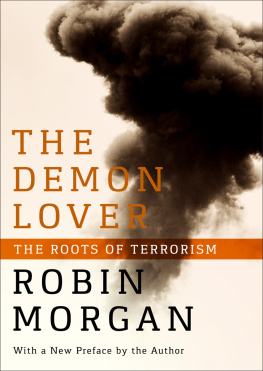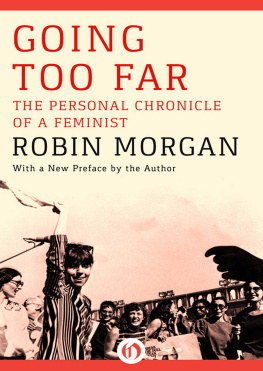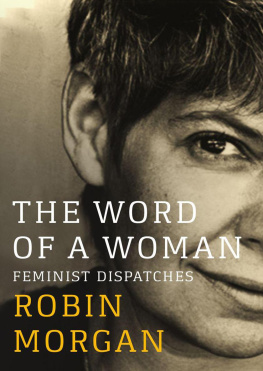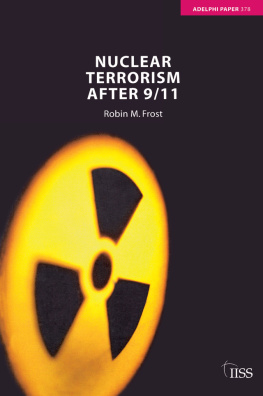Contents
CHAPTER 1
Everymans Politics: The Democratization of Violence
CHAPTER 2
The Deadly Hero: The Oldest Profession
CHAPTER 3
The Love-Death: Religion, Philosophy, and Aesthetics
CHAPTER 4
Official Terrorism: The State of Man
CHAPTER 5
Wargasm: The Revolutionary High
CHAPTER 6
Token Terrorist: The Demon Lovers Woman
CHAPTER 7
Longing for Catastrophe: A Personal Journey
CHAPTER 8
What Do Men Know About Life?: The Middle East
CHAPTER 9
The Normalization of Terror: A Note Passed Between Hostages
CHAPTER 10
Beyond Terror: The Politics of Eros
Preface
The Demon Lover, first published in 1989, then rereleased in an updated edition in 2001, has accumulated new opening remarks with each incarnation, though Ive managed to restrain myself from introducing the foreign language editions. The prefatory notes were my attempts to keep current with what in 1989 I had termed the normalization of terror and the democratization of fear. But reality outpaces me.
At this writing, the Middle East is aflame again. Israel and Palestine. Syria. Egypt and Libya and other Arab Spring countries are shuddering through counterrevolutions and counter-counterrevolutions. East Asia is convulsing over Afghanistan (again)and over Russias incremental reannexations, carried out by a leader apparently obsessed with his manhood. Massive drug cartels brutally rule various Central American nations. Right-wingers in the United States scream threats at child refugees risking their lives to cross the border to safety, and good ole boys flaunt secessionist flags and threaten openly about how the US government deserves to be terrorized. Everyday headlines blare a now-familiar repertory of alarms: bioterrorism, cyberterrorism, ecoterrorism, narcoterrorism. The gun epidemic manifests itself as terror in kindergartens, in movie theaters, in shopping malls. Everywhere, the young men swagger, firing their weapons into the airin Gaza, in Kabul, in Tripoli, in Ukraine, in Arizona. Everywhere, the women weep and mourn.
Im grateful that I wrote The Demon Lover; if I hadnt already done so, I would have to be writing it now. Because although there is today much greater sophistication about terrorism and much greater recognition of sexism, there is still deplorably little thinking that makes the connections between the two.
One major exception is the important book Sex and World Peace (Columbia University Press, 2012). In an in-depth, multidisciplinary, multicultural, multicountry study, authors Valerie M. Hudson, Bonnie Ballif-Spanvill, Mary Caprioli, and Chad F. Emmett have finally, empirically proven what feminists have understood experientially for decades: The best predictor of a states peacefulness is not any of the qualities weve believed to datenot its levels of civil society, wealth, education, or democracy, not its religion, GDP, technology, natural resources, or geopolitical status. The best predictor of a states peacefulness is how well its women are treated. The link between the security of women and that of a given state is profound; the larger the gap between men and women in a society, the more likely a nation is to be involved in intra- and interstate conflict, to be the aggressor, to use force first, and to resort to higher levels of violence.
So we must go back to the source after all, and reassess our previous assumptions about manhoodwhich are in fact changing, but must do so at an accelerated pace if humanity is to survive. We must yet again pick at the strands that knot together manliness and domination, masculinity and violence. We must return to the deep places in our own memories and nightmares where we allwomen and men alikehave been taught to eroticize violence and define power as something over, not to. And we must commit ourselves to imagine the alternatives, which can feel like inventing colors never before seen.
I desperately wish this book were out of date. But The Demon Lover remains as timely as todays breaking news. So I offer it here again, together with the original introduction plus the 2001 introduction and afterword, written after 9/11. Just reading that progression is illuminating.
The roots of terrorism run deep, and they run close to home, closer to the heart than any of us like to think. If there is to be sentient life on this planet, we must finally disempower The Demon Lover so that we can rise free of him, fully human and at peace.
Robin Morgan
New York City
August 2014
Isolated Incidents:
Introduction to the 2001 Edition
What will it take to make them hear?
Its said that women are societys canaries in the mineliving alerts to dangerand its true that a civilization can be gauged by the status of its female citizens. But miners pay attention to the canaries health and reactions, since they know that this information is crucial to their own survival. So far35 years into the current feminist wave, and despite remarkable gains wonwarnings from female human beings still are not heeded sufficiently, and most male human beings still dont understand that their own lives depend on that heeding.
Since 1995, the international womens movement has been banging on doors about the extreme human-rights violations against women in Afghanistan. Gender apartheid, weve termed it. Actually, given the epidemic of female suicides there now, it is, in effect, ethnic cleansing in a new form: gender cleansing. When a state murders minority populations, its called genocide; when a state murders some of its general population (Stalins USSR, Maos Cultural Revolution), its called democide. When a state murders its women citizens, its not hyperbole to call it femicide. So we banged on doors. Some said it was those crazy feminists again, with their victimology whines (e.g., kill the messenger as well as the subject). Postmodernists waved us off with trendy cultural relativism arguments. The U.S. ignored us because oil-pipeline interests wanted to maintain dialogue with the Taliban. The UN sacrificed women to what was judged more important: striking a deal with the Taliban over ending opium-poppy farming. The worlds fury was louder over Taliban destruction of two ancient statues, the great Bamian Buddhas, than over the abominations against women.

















